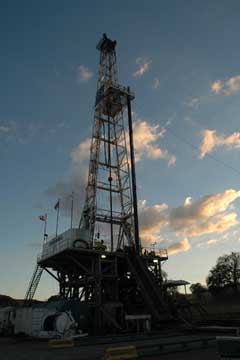|
NEWS NOTES
Earthquakes
Talc may reduce friction at creeping fault
 Courtesy of Earthscope-SAFOD |
| A three-kilometer-deep borehole drilled by SAFOD in 2005 crossed the central “creeping” part of the San Andreas Fault, producing rock cuttings containing both serpentinite and talc. |
Although it is famous for sudden, catastrophic earthquakes, some sections of California’s 1,300-kilometer-long San Andreas Fault creep along steadily, releasing tension slowly and thus producing much smaller temblors. The source of creep has long been a mystery, but new evidence from a deep drillhole in the fault zone suggests that the super-soft mineral talc may be greasing the fault’s wheels.
The San Andreas Fault system in coastal California, a jagged zone of broken, fractured and pulverized rock as much as a kilometer wide and 16 kilometers deep, sketches the boundary between two slowly moving tectonic plates — the Pacific Plate to the west and the North American Plate to the east. Extending from just offshore of Eureka in Northern California to the Salton Sea in Southern California, and encompassing several branching faults (including the San Jacinto and the Banning faults south of Cajon Pass), the San Andreas is arguably the most famous transform fault in the world. It is the source of several giant earthquakes, including the famous 1906 earthquake that sparked city-wide fires in San Francisco and killed about 3,000 people.
Not all parts of the San Andreas Fault produce giant earthquakes, however. While the northern and southern parts of the fault tend to “lock” as the two plates slide against each other — building up strain and then suddenly, catastrophically releasing it, thereby producing infrequent but powerful earthquakes — the central part of the fault tends to “creep,” moving more slowly and steadily, and producing earthquakes of far smaller magnitude, says Diane Moore, a geologist with the U.S. Geological Survey (USGS) in Menlo Park, Calif.
Why the central part of the San Andreas creeps while other parts of the fault lock has been a puzzle for decades, Moore says. One possible culprit is a soft, soapy-textured rock called serpentinite, which often appears in outcrops in the creeping fault zones and is dominated by a mineral that gives way relatively easily to shearing forces — possibly reducing friction caused by plate movement. But serpentinite, which is produced by metamorphic alteration of mantle and oceanic crustal rocks, becomes too strong with depth to sufficiently ease friction and cause creep, Moore says. Furthermore, laboratory experiments show that serpentinite-group minerals can cause “unstable slip” along a fault, becoming weaker when the fault slides more quickly — and thus potentially enhancing the power of an earthquake rather than dampening it, she says.
Moore and Michael Rymer, also a geologist at USGS in Menlo Park, Calif., have now identified a new possible reason for the creep: the mineral talc. Moore and Rymer analyzed rocks collected at three-meter intervals from a three-kilometer-deep borehole drilled into the creeping section of the fault by the USGS/National Science Foundation project San Andreas Fault Observatory at Depth (SAFOD) in 2005. While studying the serpentinite grains from the drill rocks, they discovered that the grains contained veins of talc, which form when heated groundwater containing silica interacts with serpentinite. That’s particularly significant because talc is extremely soft and weak, and may be the only mineral that alone could satisfy the conditions for a weak San Andreas Fault at depth, they wrote Aug. 16 in Nature.
There are other potential explanations for the creep, including the presence of high fluid pressures that could also reduce friction, Moore says. But there is no evidence of such fluid pressures in the drill hole, at least as far down as three kilometers, she says.
The scientists are currently doing laboratory experiments to determine how much talc needs to be present to “make a difference,” Moore says. The amount of talc the team found was “extremely small,” she says, but preliminary lab experiments, the results of which she will present at the Geological Society of America meeting in Denver, Colo., later this month, suggest that such small amounts may indeed be sufficient to reduce friction and produce creep.
The find is “a very appealing explanation for why a fault can creep in some places, but break catastrophically in others,” says Christopher Wibberley, a geologist at the Université de Nice Sophia Antipolis in Valbonne, France. It’s also a good “early hit” for the young SAFOD project, which is currently doing more drilling along side tracks of the fault to study heterogeneity of rock types and geometries around the fault, Wibberley says. “There are exciting times ahead,” he says. “What else are they going to discover down there?”

 Subscribe
Subscribe


